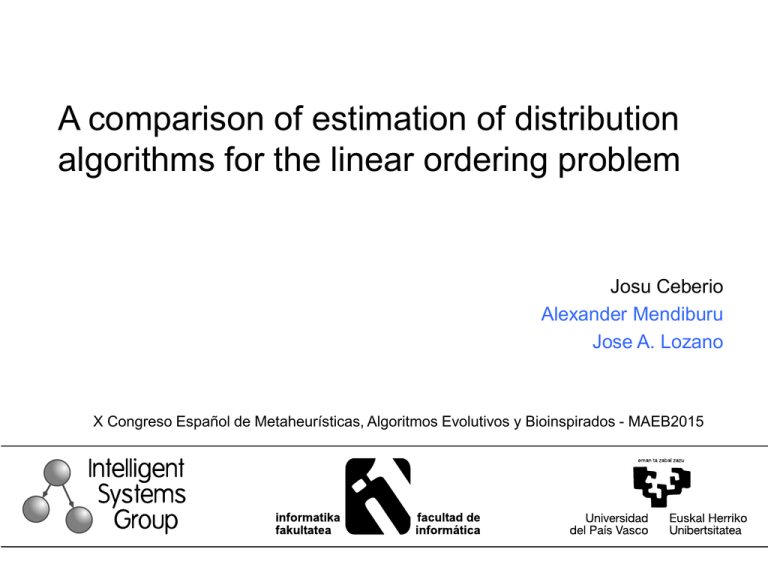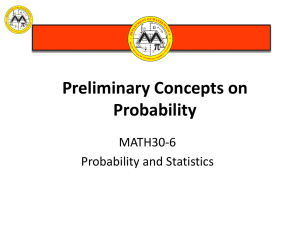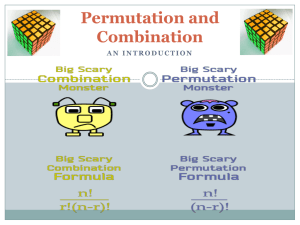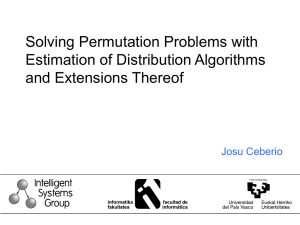Solving Permutation Problems with Estimation of Distribution
advertisement

A comparison of estimation of distribution
algorithms for the linear ordering problem
Josu Ceberio
Alexander Mendiburu
Jose A. Lozano
X Congreso Español de Metaheurísticas, Algoritmos Evolutivos y Bioinspirados - MAEB2015
Outline
• The linear ordering problem
• The Mallows and Plackett-Luce EDAs
• Experimentation
• On the Boltzmann distribution associated to the LOP
• Conclusions and future work
2
Permutation optimization problems
Definition
Combinatorial optimization problems
3
Permutation optimization problems
Definition
Problems whose solutions are naturally represented
as permutations
4
Permutation optimization problems
Goal
To find the permutation solution that minimizes
a fitness function
The search space
consists of
solutions.
5
Permutation optimization problems
Examples
• Travelling salesman problem (TSP)
• Permutation Flowshop Scheduling Problem (PFSP)
• Linear Ordering Problem (LOP)
• Quadratic Assignment Problem (QAP)
6
Permutation optimization problems
Examples
• Travelling salesman problem (TSP)
• Permutation Flowshop Scheduling Problem (PFSP)
• Linear Ordering Problem (LOP)
• Quadratic Assignment Problem (QAP)
7
The linear ordering problem
Definition
0
16
11
15
7
21
0
14
15
9
26
23
0
26
12
22
22
11
0
13
30
28
25
24
0
Example extracted from R. Martí and G. Reinelt (2011)
The linear ordering problem: exact and heuristic methods
in combinatorial optimization.
8
The linear ordering problem
Definition
1
2
3
4
5
1
0
16
11
15
7
2
21
0
14
15
9
3
26
23
0
26
12
4
22
22
11
0
13
5
30
28
25
24
0
Example extracted from R. Martí and G. Reinelt (2011)
The linear ordering problem: exact and heuristic methods
in combinatorial optimization.
9
The linear ordering problem
Definition
5
3
4
2
1
5
0
25
24
28
30
3
12
0
26
23
26
4
13
11
0
22
22
2
9
14
15
0
21
1
7
11
15
16
0
Example extracted from R. Martí and G. Reinelt (2011)
The linear ordering problem: exact and heuristic methods
in combinatorial optimization.
10
The linear ordering problem
Some applications
- Aggregation of individual preferences
- Kemeny ranking problem
- Triangulation of input-output tables of the branches of an
economy
- Ranking in sports tournaments
- Optimal weighted ancestry relationships
11
The linear ordering problem
It is an NP-hard problem
(Garey and Johnson 1979)
12
Estimation of distribution algorithms
Definition
13
In previous works
• Implement probability models for permutation domains
– The Mallows model
– The Generalized Mallows model
– The Plackett-Luce model
14
In previous works
• Implement probability models for permutation domains
– The Mallows model
– The Generalized Mallows model
– The Plackett-Luce model
Promising performance
on the LOP
15
The Mallows model
Definition
•
A distance-based exponential probability model
•
Central permutation
•
Spread parameter
•
A distance on permutations
16
The Mallows model
Definition
•
A distance-based exponential probability model
•
Central permutation
•
Spread parameter
•
A distance on permutations
17
The Mallows model
Definition
•
A distance-based exponential probability model
•
Central permutation
•
Spread parameter
•
A distance on permutations
18
The Ulam distance
Definition
Calculates the minimum number of insert operations to convert
.
in
19
Distances and neighborhoods
Swap neighborhood
– Two solutions
and
and
are neighbors if the Kendall’s-τ distance between
is
Interchange neighborhood
– Two solutions
and
and
are neighbors if the Cayley distance between
and
are neighbors if the Ulam distance between
is
Insert neighborhood
– Two solutions
and
is
20
Distances and neighborhoods
Swap neighborhood
– Two solutions
and
and
are neighbors if the Kendall’s-τ distance between
is
Interchange neighborhood
– Two solutions
and
and
are neighbors if the Cayley distance between
and
are neighbors if the Ulam distance between
is
Insert neighborhood
– Two solutions
and
is
21
The Plackett- Luce model
Definition
The probability of
under the Plackett-Luce model is given by
The vector of scores
defines the preference
of each item to be ranked in top rank
22
The Plackett- Luce model
Vase model interpretation
A vase of infinite colored balls
With known proportions of each color
Draw balls from the vase until a permutation
of colored balls is obtained
23
The Plackett- Luce model
Vase model interpretation
Stage 1
We draw a ball. And it is red.
The probability to extract a red ball at
this stage is:
24
The Plackett- Luce model
Vase model interpretation
Stage 2
We draw another ball. And it is green.
The probability to extract a green ball
from the remaining balls is:
25
The Plackett- Luce model
Vase model interpretation
Stage 3
We draw the blue ball.
The probability to extract a blue ball is:
26
L-decomposability
1
2
3
4
5
1
0
16
11
15
7
2
21
0
14
15
9
3
26
23
0
26
12
4
22
22
11
0
13
5
30
28
25
24
0
27
L-decomposability
1
2
3
4
5
2
1
3
5
4
1
0
16
11
15
7
2
0
21
14
9
15
2
21
0
14
15
9
1
16
0
11
7
15
3
26
23
0
26
12
3
23
26
0
12
26
4
22
22
11
0
13
5
28
30
25
0
24
5
30
28
25
24
0
4
22
22
11
13
0
28
Experiments
Design
•
Algorithms:
-
Mallows EDA under the Ulam distance (MaEDA)
-
Plackett-Luce EDA (PLEDA)
•
50 instances of sizes: {10, 20, 30, 40, 50, 60, 70, 80, 90, 100}
•
Average Relative Percentage Deviation (ARPD) of 20 repetitions
•
Stopping criterion: 100n-1 generations
29
Experiments
Results
ARPD
ARPD results of 20 repetitions of the EDAs for the LOP instances
0.05
MaEDA
PLEDA
0.04
0.03
0.02
0.01
0
10
20
30
40
50
60
70
Instance Size
80
90
100
30
Discussion
Which is the most efficient model to optimize the LOP ?
31
Discussion
Theoretically, the Boltzmann distribution associated to the LOP
Boltzmann
constant
32
Discussion
Calculate from the Boltzmann distribution associated to the LOP:
• the Mallows model under the Ulam distance
• the Plackett-Luce model
Learn from a sample of
106 permutations
Perform a weighted
computation
of the parameters
4 instances of size n=7
Boltzmann constant c: [0,300]
Kullback-Leibler divergence:
33
Probability concentrates
in the fittest solutions
Discussion
Near uniform distribution
34
Conclusions
• For small instances, MaEDA and PLEDA obtain similar results.
• For large instances, MaEDA is the preferred algorithm.
• With respect to the Boltzmann distribution of the LOP:
– When the fitness of the solutions is very different, the Mallows model under the
Ulam distance is the preferred option.
– When the fitness of the solutions is similar, the Plackett-Luce is more accurate.
35
Future work
Compare Mallows EDA under the Ulam distance
with state-of-the-art algorithms
36
Future work
Study the properties of the Boltzmann distribution on the LOP
37
A comparison of estimation of distribution
algorithms for the linear ordering problem
Josu Ceberio
Alexander Mendiburu
Jose A. Lozano
X Congreso Español de Metaheurísticas, Algoritmos Evolutivos y Bioinspirados - MAEB2015









